Fatigue Crack Detection Based on Semantic Segmentation Using DeepLabV3+ for Steel Girder Bridges
Abstract
1. Introduction
2. Overview of Semantic Segmentation Model: DeepLabv3+
3. Proposed Fatigue Crack Detection Model Based on Sematic Segmentation
3.1. Overview of the Proposed Model
3.2. Classification Network ResNet50_crack
- (1)
- Initial dataset for classification network
- (2)
- Image screening based on active learning
- (3)
- Training classification network ResNet50_crack
3.3. Semantic Segmentation Network DeepLabv3 + for Crack Detection
4. Comparative Studies of Different Models
- (1)
- Comparison of semantic segmentation indicators
5. Pixel Category Threshold Optimization
6. Fatigue Crack Detection Results Using the Proposed Model
7. Conclusions
Author Contributions
Funding
Institutional Review Board Statement
Informed Consent Statement
Data Availability Statement
Conflicts of Interest
References
- Zhang, Y.; Li, H.; Wang, Y. Fatigue Crack Detection in Steel Beams Using Support Vector Machines. J. Struct. Health Monit. 2020, 15, 234–246. [Google Scholar]
- Li, Z.; Zhao, J.; Chen, Q. K-Nearest Neighbors-Based Crack Detection Using Strain Data from Steel Girder Bridges. Struct. Control Health Monit. 2019, 26, e2467. [Google Scholar]
- Kim, S.; Park, J.; Choi, J. Drone-Based Crack Detection in Steel Bridges Using Convolutional Neural Networks. Autom. Constr. 2021, 126, 103675. [Google Scholar]
- Yang, Y.; Yao, X. Multi-Scale Convolutional Neural Network for Crack Detection in Steel Bridges. Eng. Struct. 2023, 259, 114245. [Google Scholar]
- Chen, L.; Papandreou, G.; Kokkinos, I.; Murphy, K.; Yuille, A.L. DeepLabv3+: Semantic Image Segmentation with Deep Convolutional Nets, Atrous Convolution, and Fully Connected CRFs. IEEE Trans. Pattern Anal. Mach. Intell. 2018, 40, 834–848. [Google Scholar] [CrossRef]
- Chen, L.C.; Zhu, Y.; Papandreou, G.; Schroff, F.; Adam, H. Encoder-Decoder with Atrous Separable Convolution for Semantic Image Segmentation. In Proceedings of the European Conference on Computer Vision (ECCV), Tel Aviv, Israel, 23–27 October 2022; Springer: Cham, Switzerland, 2019; pp. 801–818. [Google Scholar]
- Ronneberger, O.; Fischer, P.; Brox, T. U-Net: Convolutional Networks for Biomedical Image Segmentation. In Medical Image Computing and Computer-Assisted Intervention (MICCAI); Springer: Cham, Switzerland, 2015; Volume 9351, pp. 234–241. [Google Scholar]
- Xu, K.; Zhang, J.; Li, W. Transfer Learning for Crack Detection in Steel Bridges. Comput.-Aided Civ. Infrastruct. Eng. 2023, 38, 265–278. [Google Scholar]
- Long, J.; Shelhamer, E.; Darrell, T. Fully Convolutional Networks for Semantic Segmentation. In Proceedings of the IEEE Conference on Computer Vision and Pattern Recognition, Boston, MA, USA, 15 October 2015; pp. 3431–3440. [Google Scholar]
- He, K.; Zhang, X.; Ren, S.; Sun, J. Deep Residual Learning for Image Recognition. In Proceedings of the IEEE Conference on Computer Vision and Pattern Recognition, Las Vegas, NV, USA, 12 December 2016; pp. 770–778. [Google Scholar]
- Settles, B. Active Learning Literature Survey; Computer Sciences Technical Report 1648; University of Wisconsin-Madison: Madison, WI, USA, 2009. [Google Scholar]
- Wang, Z.; Xu, G.; Ding, Y.; Wu, B.; Lu, G. A vision-based active learning convolutional neural network model for concrete surface crack detection. Adv. Struct. Eng. 2020, 23, 2952–2964. [Google Scholar] [CrossRef]
- Rukundo, O. Effects of Image Size on Deep Learning. Electronics 2023, 12, 985. [Google Scholar] [CrossRef]
- Rukundo, O. Evaluation of extra pixel interpolation with mask processing for medical image segmentation with deep learning. Signal Image Video Process. 2024, 18, 1–8. [Google Scholar] [CrossRef]
- Mark, S.; Andrew, H.; Menglong, Z.; Andrey, Z. Mobilenetv2: Inverted residuals and linear bottlenecks. In Proceedings of the IEEE Conference on Computer Vision and Pattern Recognition, Salt Lake City, UT, USA, 18–23 June 2018; pp. 4510–4520. [Google Scholar]
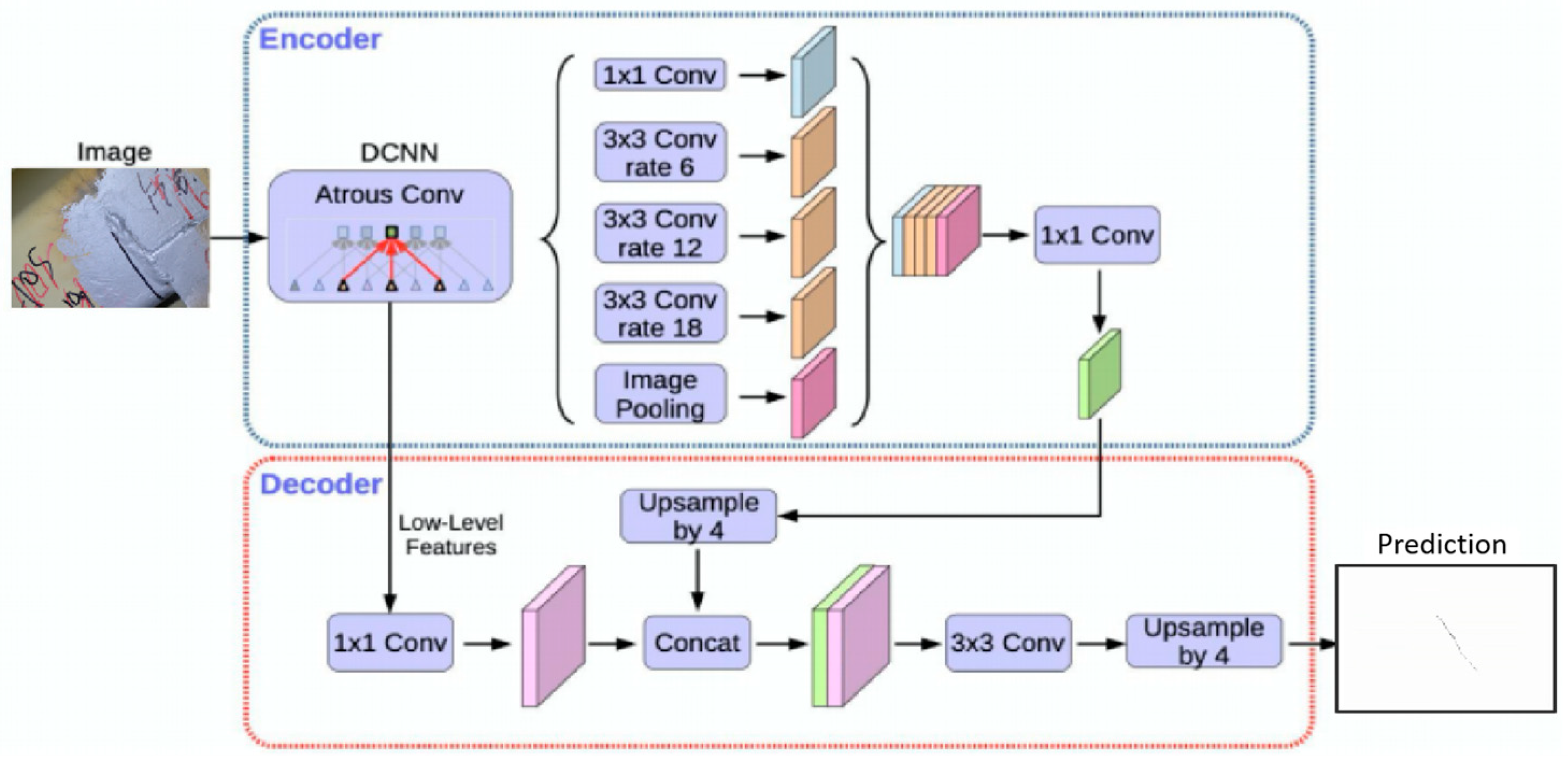
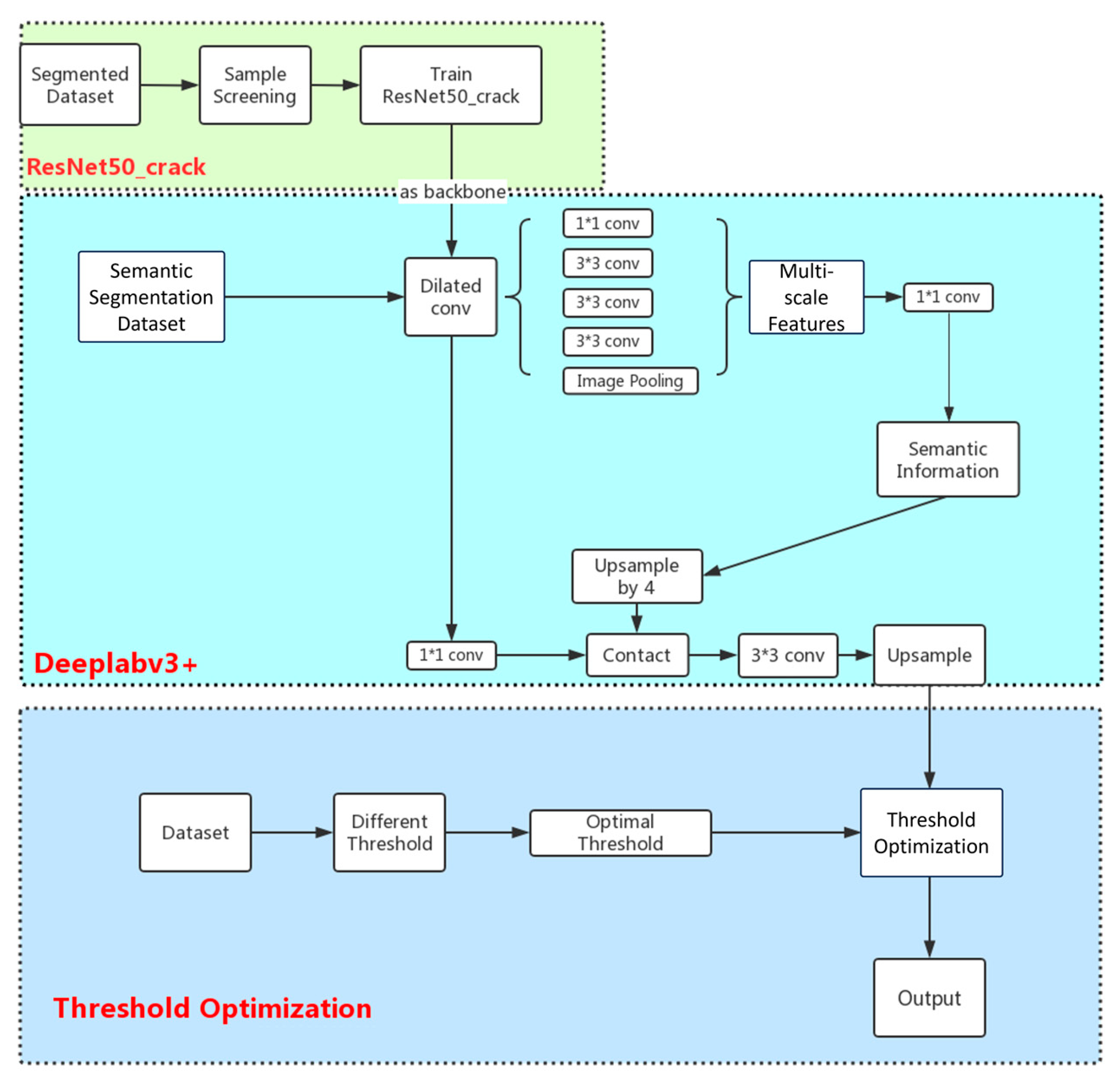

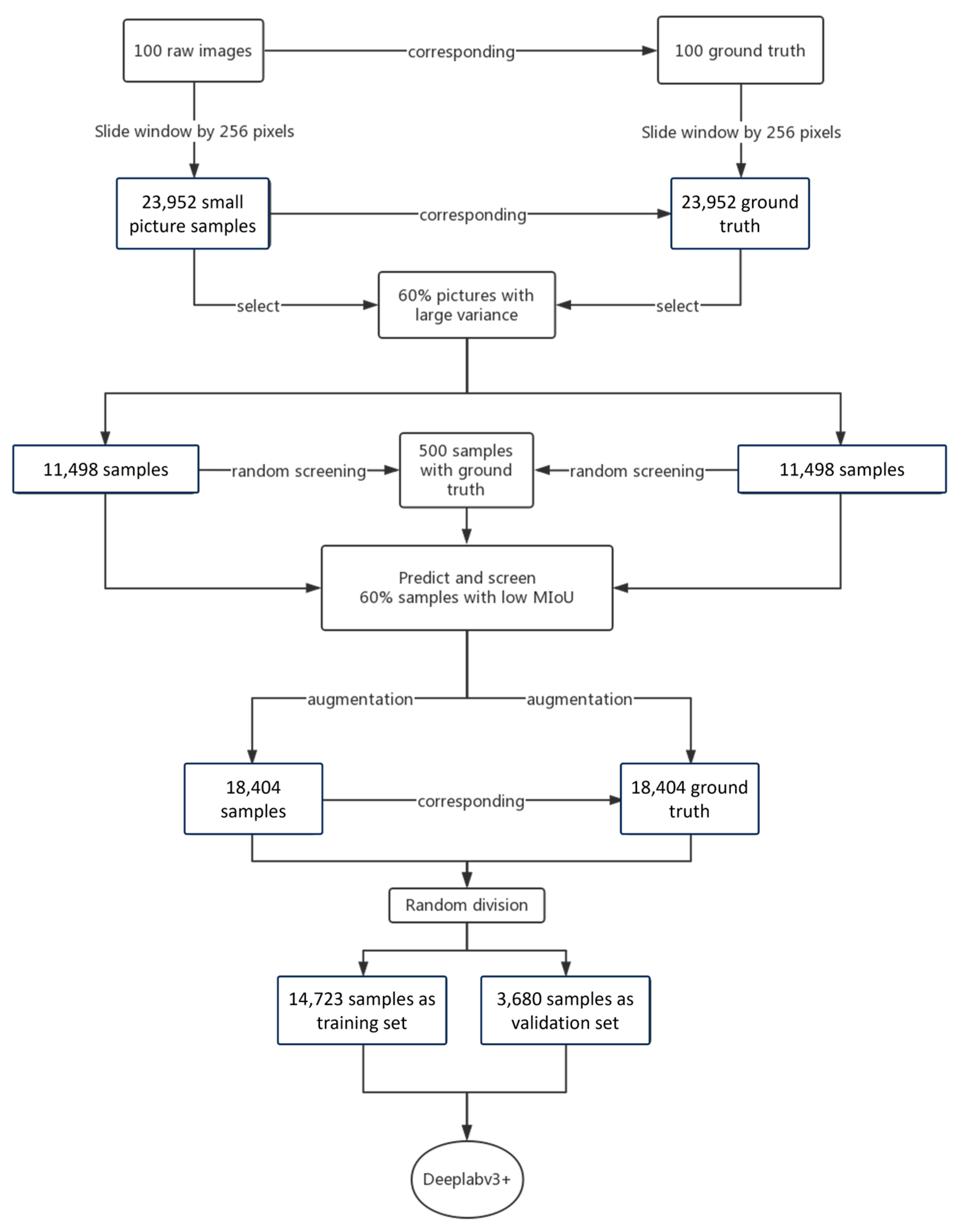

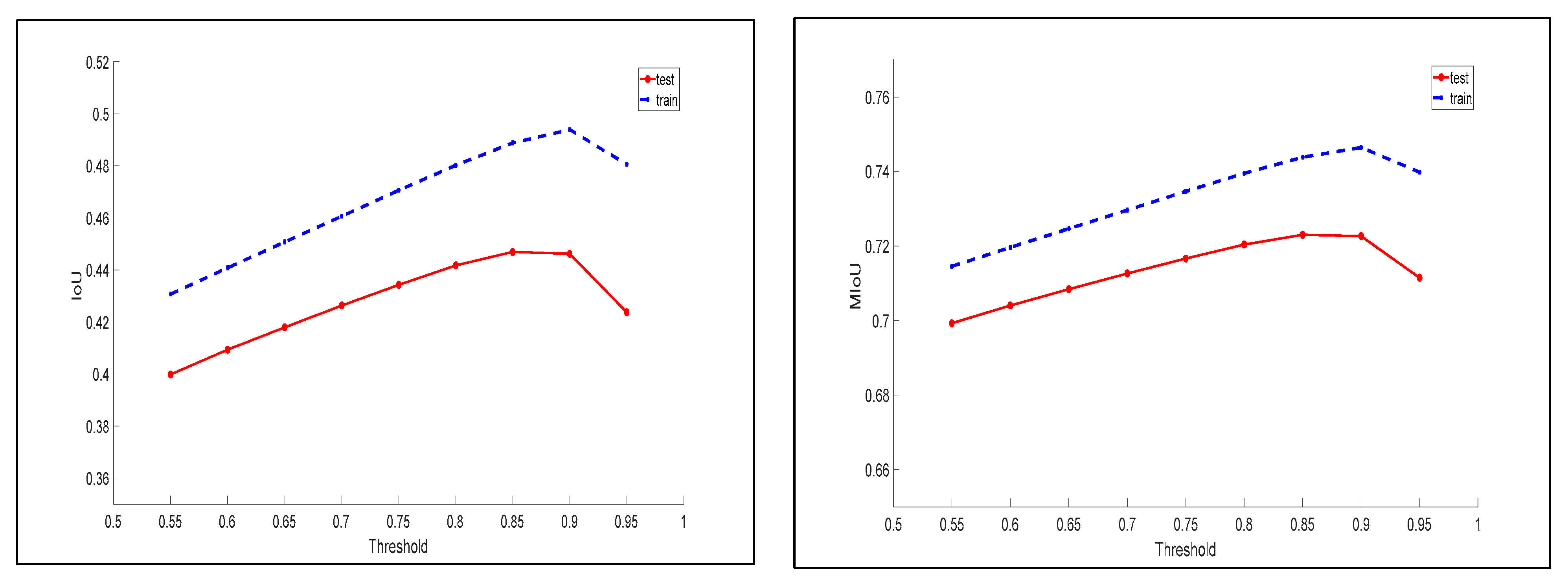
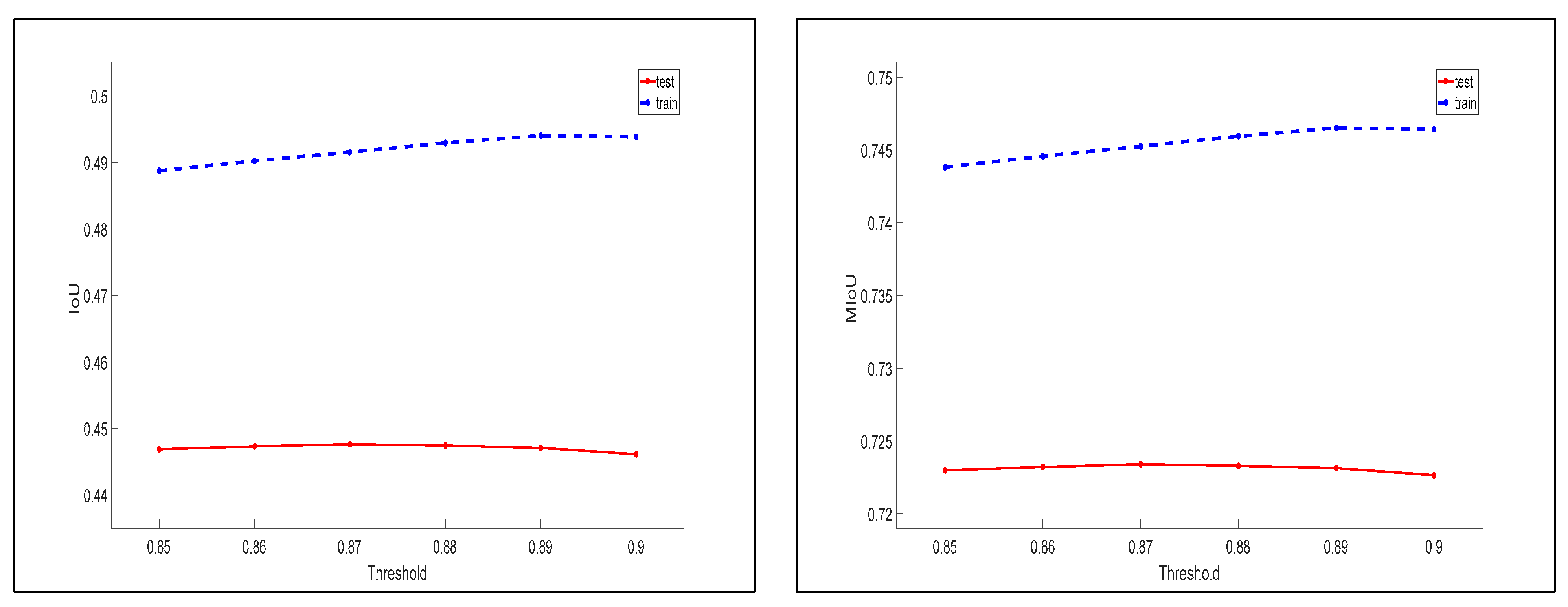
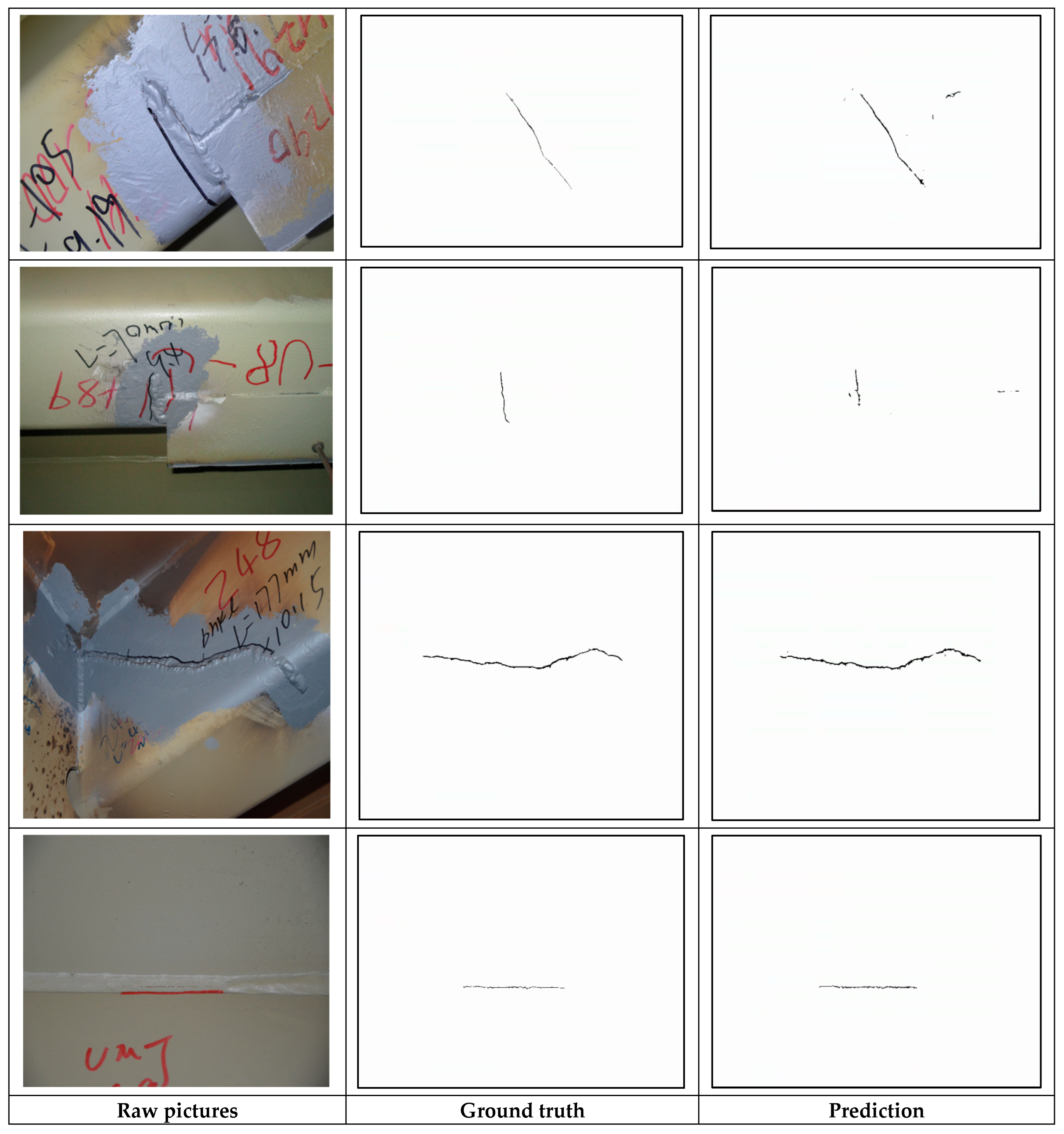
| Network Type | Time (h) | Training Accuracy of Crack Pixels | Training Accuracy of Background Pixels | Global Accuracy | Validation Accuracy |
|---|---|---|---|---|---|
| Model 1: DeeplabV3+, ResNet50 | 18.9 | 78.52% | 99.74% | 99.71% | 99.11% |
| Model 2: DeeplabV3+, MobileNet-v2 | 14.7 | 70.09% | 99.67% | 99.64% | 99.00% |
| Proposed Model: DeeplabV3+, ResNet50_crack, Active Learning | 12.25 | 75.59% | 99.89% | 99.86% | 99.26% |
| Network Type | IoU | MIoU | |
|---|---|---|---|
| Crack | Background | ||
| Model 1: DeeplabV3+, ResNet50 | 0.2391 | 0.9971 | 0.6181 |
| Model 2: DeeplabV3+, MobileNet-v2 | 0.1910 | 0.9964 | 0.5937 |
| Proposed Model: DeeplabV3+, ResNet50_crack, Active Learning | 0.3897 | 0.9986 | 0.6942 |
Disclaimer/Publisher’s Note: The statements, opinions and data contained in all publications are solely those of the individual author(s) and contributor(s) and not of MDPI and/or the editor(s). MDPI and/or the editor(s) disclaim responsibility for any injury to people or property resulting from any ideas, methods, instructions or products referred to in the content. |
© 2024 by the authors. Licensee MDPI, Basel, Switzerland. This article is an open access article distributed under the terms and conditions of the Creative Commons Attribution (CC BY) license (https://creativecommons.org/licenses/by/4.0/).
Share and Cite
Jia, X.; Wang, Y.; Wang, Z. Fatigue Crack Detection Based on Semantic Segmentation Using DeepLabV3+ for Steel Girder Bridges. Appl. Sci. 2024, 14, 8132. https://doi.org/10.3390/app14188132
Jia X, Wang Y, Wang Z. Fatigue Crack Detection Based on Semantic Segmentation Using DeepLabV3+ for Steel Girder Bridges. Applied Sciences. 2024; 14(18):8132. https://doi.org/10.3390/app14188132
Chicago/Turabian StyleJia, Xuejun, Yuxiang Wang, and Zhen Wang. 2024. "Fatigue Crack Detection Based on Semantic Segmentation Using DeepLabV3+ for Steel Girder Bridges" Applied Sciences 14, no. 18: 8132. https://doi.org/10.3390/app14188132
APA StyleJia, X., Wang, Y., & Wang, Z. (2024). Fatigue Crack Detection Based on Semantic Segmentation Using DeepLabV3+ for Steel Girder Bridges. Applied Sciences, 14(18), 8132. https://doi.org/10.3390/app14188132





